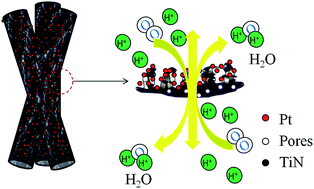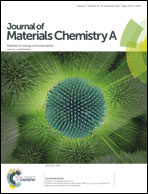Hollow and porous titanium nitride nanotubes as high-performance catalyst supports for oxygen reduction reaction†
Abstract
We describe a route to the development of robust non-carbon TiN nanotubes (TiN NTs) used as a support for Pt, and the catalyst exhibits high activity and stability for the oxygen reduction reaction (ORR). The accelerated durability test (ADT) reveals that the novel supporting material can dramatically enhance the durability of the catalyst and maintain the electrochemically active surface area (ECSA) of Pt, which shows great improvement in ECSA loss with 77% of the initial ECSA remaining even after 12 000 ADT cycles, which is much higher than the commercial Pt/C (E-TEK) catalyst. The experimental data verified the strong metal/support interaction between Pt nanoparticles (NPs) and the TiN NTs support. The surface of the TiN NTs is composed of dendrite nanocrystals, which may function as ‘hunters’ for re-capture and re-nucleation of the Pt species (atoms or clusters) that would dissolve into the electrolyte, which prevents leaching and migrating of dissolved Pt NPs. This new approach opens a reliable path for designing various TiN NT-supported catalysts for a wide range of applications in energy conversion processes.


 Please wait while we load your content...
Please wait while we load your content...